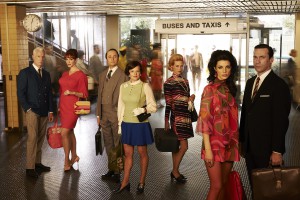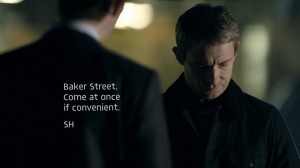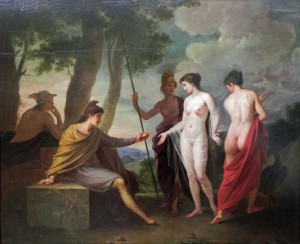“Television Aesthetics” versus Formal and Stylistic Analysis
 In the inaugural post of this series, Kyle Conway reminded us that our term aesthetics “derives from αἰσθάνομαι, which refers to perception or experience.” From the perspective of television studies it is hard to imagine reclaiming this original meaning, given the welter of connotations that envelops the term today. In this post I shall suggest that there is an urgent need to sift the divergent meanings for “aesthetic” currently in play in television studies, and ideally to limit usage in the interests of clarity.
In the inaugural post of this series, Kyle Conway reminded us that our term aesthetics “derives from αἰσθάνομαι, which refers to perception or experience.” From the perspective of television studies it is hard to imagine reclaiming this original meaning, given the welter of connotations that envelops the term today. In this post I shall suggest that there is an urgent need to sift the divergent meanings for “aesthetic” currently in play in television studies, and ideally to limit usage in the interests of clarity.
In particular, I want to reflect on the fact that when we talk of the aesthetic of a particular text or textual set—e.g. “the Mad Men aesthetic,” or “the Sherlock aesthetic”—the word aesthetic is really just a conventionalized alternative to the term style. Looking back on recent scholarship on television aesthetics (including my own work), I find unacknowledged tensions between the adjectival form of “aesthetic”—used in formations such as aesthetic judgment, aesthetic attitude, aesthetic object and aesthetic category—and the singular nounal form, which connotes the cluster of formal and stylistic properties that define a particular text or textual set. These two usages are now routinely yoked to one another in the literature of television studies—as in the recent collection Television Aesthetics and Style—in spite of the fact that they represent very different kinds of engagement with texts, and have very different academic histories and profiles.  In television studies and elsewhere, the adjectival form of “aesthetic” almost invariably points to an evaluative project that has its roots in Enlightenment debates about the nature of taste and the ontological status of art. Such debates, which not only address the difference between categories (such as the beautiful and the sublime), but also account for the pleasures of art and distinguish art from non-art, have had considerable influence. Over the last two hundred years, Enlightenment aesthetics has profoundly affected the critical study of literature, music and the fine arts in the academy, as well as journalistic artistic criticism and the rhetoric of the art markets. One of its most enduring effects has been the formation of artistic canons – and corresponding exclusions. Of late, scholars such as Jason Mittell, Jason Jacobs, and Sarah Cardwell have championed this kind of evaluative approach in television studies.[1] Thus, Cardwell feels able to claim that certain television programs “are more likely than others to proffer aesthetic qualities valuable to the television aesthetician,”[2] while Mittell more bluntly speaks of identifying a given program not only as “great” but also “better than others.”[3] This approach has inevitably been controversial in a discipline historically driven by the imperatives of cultural studies, which does not recognize absolute or transcendental values and always seeks to locate value judgments in discursively specific contexts.
In television studies and elsewhere, the adjectival form of “aesthetic” almost invariably points to an evaluative project that has its roots in Enlightenment debates about the nature of taste and the ontological status of art. Such debates, which not only address the difference between categories (such as the beautiful and the sublime), but also account for the pleasures of art and distinguish art from non-art, have had considerable influence. Over the last two hundred years, Enlightenment aesthetics has profoundly affected the critical study of literature, music and the fine arts in the academy, as well as journalistic artistic criticism and the rhetoric of the art markets. One of its most enduring effects has been the formation of artistic canons – and corresponding exclusions. Of late, scholars such as Jason Mittell, Jason Jacobs, and Sarah Cardwell have championed this kind of evaluative approach in television studies.[1] Thus, Cardwell feels able to claim that certain television programs “are more likely than others to proffer aesthetic qualities valuable to the television aesthetician,”[2] while Mittell more bluntly speaks of identifying a given program not only as “great” but also “better than others.”[3] This approach has inevitably been controversial in a discipline historically driven by the imperatives of cultural studies, which does not recognize absolute or transcendental values and always seeks to locate value judgments in discursively specific contexts.
The nounal form of “aesthetic,” on the other hand, tends to be used in analyses of different formal and stylistic elements within a given medium and text, not in arguments concerning excellence or its absence. Engagement with “an aesthetic” in this sense ought to be less contentious for television studies than evaluative aesthetics à la Cardwell and Mittell. Articulating elements and principles of design and style, and considering how or why they might be discernible in a given text or cluster of texts, does not per se constitute a value judgment about that text’s relative status. Indeed, I would argue that formal analysis should not be considered a function of aesthetics at all: connections between formal analysis and aesthetic judgment were only ever historically contingent, not inherent, in humanistic disciplines such as art history and literary studies. My initial academic formation was in art history, where analysis of form and style has always been a crucial disciplinary tool. Its usefulness as such has not dwindled as old models privileging connoisseurship, narratives of “great men,” and the autonomous history of style have given place over the last half-century to studies informed by Marxist social history, feminism, semiotics, reception theory, and so on. At no point, from the time of Wölfflin and Riegl to the present, has formal or stylistic analysis in art history required aesthetics as a justificatory prop.

“Judgement of Paris,” Joseph Hauber (1819, Neue Pinakothek, Munich)
So why do some scholars of television feel the need to invoke aesthetics, rather than being content with the less portentous terms form and style? I wonder if the urge does not stem from a collective desire to lend gravitas to a project that for some is still a questionable distraction from the “real” work of television studies. Perhaps we are too used to the now-automatic legitimation conferred by the politically informed, latently activist ethos of cultural studies, and feel exposed when we fear we are operating outside its ambit. If so, the irony is that by taking refuge under the aegis of aesthetics, scholars of television risk creating a false dichotomy. When formal and stylistic analysis are lumped with aesthetics, as opposed to being understood as tools in their own right, it is easy to lose sight of the fact they can inform a wide array of interpretive engagements with television – including the work done by those of us whom Cardwell would class as “aesthetics skeptics.” In other words, unlike aesthetics-as-evaluation, formal and stylistic analysis need not cut and cross with the longstanding concerns of television studies.
I’m grateful to Eliza Rodriguez y Gibson and Paul Booth for the conversations, critique and suggestions that helped shape this post.
[1] See, for example, the introduction and the chapters by Cardwell and Mittell in Jacobs and Peacock. [2] Jacobs and Peacock, p. 38. [3] Ibid., pp. 3-4.



Thanks for this entry, Piers. I’ve been meaning to respond to it, but the end-of-semester busy-ness has kept me away.
I spend a lot of time parsing how people use specific words to evoke different things — that is, how people make words mean different things — so I appreciate what you’re doing here. I’m on board with calling formalism formalism if it makes work clearer. And I think there are places where “look” or “feel” or “style” might be better than “aesthetic,” such as in the case of Mad Men.
But — this will not surprise you — I’m puzzled by your reductive approach. What value is there in dismissing questions of perception and experience? Or, another way to ask this question, can you suggest a better term than “aesthetics” to talk about the experience of a show, if it is hard to imagine reclaiming the word’s original meaning?
I don’t mean these questions as veiled accusations — I’m genuinely curious, in part because I’m not entirely satisfied with the word “aesthetics,” either. Plus, I appreciate your background in art history — like so many things, I backed into the question of aesthetics accidentally. I first approached Antenna about the series on the “aesthetic turn” as a way to work through questions I found puzzling. I think work by people like Shawn VanCour (for instance, his consideration of the industrial pressures that shaped how people listened to early radio) helps us get at some rather perplexing problems. Personally, I’m interested in ideas of translation, especially between media, and the ways the experience of a translated text differs from that of the original.
I think the value of the Aesthetic Turn series has been the way people have addressed questions of experience. (And I think others have addressed it better than I, frankly.) So I wonder if you’d say a bit more about what you mean by “aesthetics.” If it’s not evaluative, and if it doesn’t consist in formal or stylistic analysis, what is it?
Many thanks for the comment, Kyle. You raise a number of important questions, and I’d like to offer a few responses – some direct, some less so.
First of all, I want to be clear that I had no intention of dismissing the questions of perception and experience raised in your post, or for that matter Shawn VanCour’s project for “a production-oriented approach to media aesthetics” that “combines close analysis of surface-level textural phenomena … with critical study of the production techniques and possibilities of media.” I find the substance of both your posts valuable not only in principle but also in (my own) practice. My concern is with the hazards of situating these things under the aegis of aesthetics. If my post came across as reductive, it is probably because it was envisaged as a polemic against cavalier use of “aesthetic” and its variants – and all polemics are necessarily in some measure reductive. Even so, I recognize that there are larger problems that I ignored in the interests of forcefully making a point.
You ask me to say more about what I mean by aesthetics, and elsewhere you ask if I can suggest a better term for discursively framing the experience of a given show. I’m going to take an oblique approach to answering these questions. Before I pared my post down to its present length I had included a further semantic distinction, beyond differentiating between the nounal and adjectival forms of aesthetic. Neither of the foregoing aligns with notion of “an aesthetics of ____” – as for example in “an aesthetics of HBO,” or more broadly “an aesthetics of television.” Here again we have a modality of the aesthetic that seems to be fuzzy in application. It’s frequently unclear what exactly is being proposed in articles or book chapters that claim to be taking us “toward an aesthetics of such-and-such” (and once again I’m certainly not guiltless in this regard). Yet “an aesthetics of …” surely ought to imply a describable system of inquiry and interpretation, a methodology—as in “a feminist aesthetics”—not a particularized reaction to a given text or a set of defining traits for that text.
With this in mind it seems to me that what your post and Shawn VanCour’s each propose, explicitly or implicitly, is an aesthetics of media – and here I want to lay stress on the indefinite article in that phrase. The value of “an aesthetics of …” is surely that it inherently allows for the coexistence of multiple, varied aesthetic engagements with a text or set of texts, rather than pointing to a monolithic interpretive or evaluative system. While I can’t straightforwardly satisfy your request for a working definition of aesthetics per se, I can say that in principle I’m content for it to be any approach that logically emerges from the existing discursive field, provided that it’s not dogmatic and exclusive. In practice, though, I can’t rid myself of the worry that the evaluative mode of aesthetic inquiry in television studies—if we can dignify it with the word “inquiry”—seems too readily to subsume, or at the very least tinge, other approaches.
This leads me to your other question, viz., is there a better term than aesthetics to help us frame questions of perception and experience? At this point I’m sure I don’t need further to belabor my unease over “aesthetic” and related words. I’ll content myself with saying that there are other ways of reflecting on experience, and that in my view there needs to be compelling reason to invoke the aesthetic in preference to one of these alternatives. In our recent email correspondence you said that you find yourself increasingly favoring “phenomenological”; I would add that we might also consider thinking in terms of the “affective.” And if we must envisage a “turn,” why could it not simply be an experiential turn?